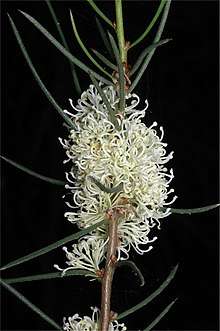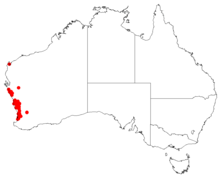Hakea candolleana
Hakea candolleana is a shrub in the family Proteaceae native to areas along the west coast in the Wheatbelt and Mid West regions of Western Australia.[2] A cream-white winter flowering species, useful as a garden ground cover.
| Hakea candolleana | |
|---|---|
 | |
| Hakea candolleana in the ANBG | |
| Scientific classification | |
| Kingdom: | Plantae |
| Clade: | Tracheophytes |
| Clade: | Angiosperms |
| Clade: | Eudicots |
| Order: | Proteales |
| Family: | Proteaceae |
| Genus: | Hakea |
| Species: | H. candolleana |
| Binomial name | |
| Hakea candolleana | |
 | |
| Occurrence data from Australasian Virtual Herbarium | |
Description
Hakea candolleana is a dense low growing lignotuberous multi-stemmed shrub. Typically growing to a height of 0.15 to 1.6 metres (0.5 to 5.2 ft) generally wider than tall. Smaller branches are densely covered in short matted hairs or flattened fine silky hairs either white or rusty coloured. Occasionally branches quickly become smooth and a bluish-green with a powdery film. The inflorescence consists of 6-8 very small white or cream flowers with a pink to greenish tinge on a stem 2–3 mm (0.08–0.1 in) long. The pedicel is 1.5–4 mm (0.06–0.2 in) long, white or cream-yellow and covered in long furry soft matted hairs or flattened silky hairs extending onto the lower part of the flower. The cream-white perianth is 2–2.6 mm (0.08–0.1 in) long. Faintly scented flowers appear in leaf axils from June to August. Leaves are alternate, flat and linear, sometimes needle-shaped ending in a hard blunt point. Length may be variable from 2.5–13 cm (1–5 in) long and 1–4 mm (0.04–0.2 in) wide more or less the same length the entire leaf. Young leaves covered in soft matted hairs becoming smooth with age. Large "S" shaped fruit are smooth 18–42 mm (0.7–2 in) long and 12–25 mm (0.5–1 in) wide aging to rough and pitted on the surface ending with an incurving beak.[3][4][5]
Taxonomy and naming
Hakea candolleana was first formally described by Carl Meissner in 1848. Hakea candolleana was named in honour of the Swiss botanist, Augustin Pyramus de Candolle.[2][3]
Distribution and habitat
Hakea candolleana grows in heath or shrubland on sand, loam and clay and requires an open sunny aspect. Often found in low lying seasonally wet areas. It grows from the northern sand plains at the Murchison River to Perth and an outlying community at Tammin.[3][4]
Conservation status
Hakea candolleana is presently listed as "not threatened" by Western Australian Government,Department of Parks and Wildlife.[2]
References
- "Hakea candolleana". APNI. Retrieved 20 January 2019.
- "Hakea candolleana". FloraBase. Western Australian Government Department of Parks and Wildlife.
- Young, J A (2006). Hakeas of Western Australia:A field and Identification Guide. J A Young. ISBN 0-9585778-2-X.
- "Hakea candolleana". Flora of South Australia. South Australian Government. Retrieved 17 February 2019.
- Wilson (ed), Annette; Barker, Robyn M.; Haegi, Laurence A.; Barker, William R. (1999). "Flora of Australia". ABRS-Department of Environment & Heritage. ISBN 0-643-06454-0.CS1 maint: extra text: authors list (link)